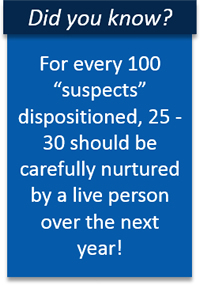There is valuable data in non-lead outcomes that, if properly nurtured, can increase marketing returns substantially. Most recently, in part 2 of this series, we discussed pipeline dispositions*—prospects that are just one or two touches away from being converted to sales-ready leads. Here in part 3, we’ll examine “nurture” dispositions. A nurture disposition is a qualified company, contact and operating environment without any specific next step in the short-term. For every 100 “suspects” dispositioned, 25 – 30 can be identified as nurture opportunities. Unfortunately, I find that most companies ignore the value of qualified nurture dispositions—meaning that while they go to the expense of identifying leads, they squander the opportunity to identify the highest potential long-term prospects. What a waste!
With that said, how does this all play out?
Identifying Nurture Opportunities
 Your inside sales support team finds out, via dialogue with decision-makers and those surrounding them, that a company is “firmographically” qualified (right size, right SIC, right location type, right geography, right contacts, etc.); and they are environmentally qualified (current solution or lack of a solution indicates they will eventually recognize pain and be in the market for what you sell). What you have here is a nurture disposition—a qualified company with at least latent pain and a decision maker or strong decision influencer identified—but they are nowhere near ready to engage in a conversation with sales. So what next? That’s where nurturing comes in.
Your inside sales support team finds out, via dialogue with decision-makers and those surrounding them, that a company is “firmographically” qualified (right size, right SIC, right location type, right geography, right contacts, etc.); and they are environmentally qualified (current solution or lack of a solution indicates they will eventually recognize pain and be in the market for what you sell). What you have here is a nurture disposition—a qualified company with at least latent pain and a decision maker or strong decision influencer identified—but they are nowhere near ready to engage in a conversation with sales. So what next? That’s where nurturing comes in.
Nurturing Nurtures
Rather than depending on scoring to trigger follow-up on this group of qualified, nurture-worthy prospects, set up trigger alerts for specific activity (such as changes in the C-Suite, mergers and acquisitions, a competitive or legislative threat, etc.). Send personal emails with recent and relevant wins, information about their industry, and ideas you have learned from all of your conversations with the market that may help the prospect—whether or not it directly benefits you. When you can get in early and drive the evaluation rather than respond to it, you will yield more and better (more strategic) wins.
At what point, then, are these ready to pass on to sales? Some (mistakenly, in my opinion) argue that a prospect isn’t sales-ready until it is BANT (budget, authority, need and timeframe) or ANUM (authority, need, urgency and money) qualified. I beg to differ. Waiting until the buyer is “70% of the way through the buying process” before getting on their radar screen is just wrong. It’s crucial to get sales involved as soon as a need/urgency has been identified. If you wait until all the stars are in alignment, more than likely you will find yourself in evaluations that have already been won by a more agile competitor. At this point you are invited to the dance simply as column fodder to compare to the already victorious winner.
To Recap
The beauty in all of this is that the math works! Let’s say we have 100 suspects identified. Of those you’ll generate (on average):
- 5 highly qualified, sales-ready leads generated from a new, “cold” list.
- 5 pipeline dispositions identified (which will convert to 1 – 2 additional, incremental leads).
- 25 – 30 companies identified as nurture dispositions. Over time, an additional 5 – 6 leads (or about 20% of the total) will result from nurturing the “nurtures.”
The result? The potential total of 11 – 13 leads—more than double than if we had stopped after our first pass through the list and started over on the next campaign. Ignoring the value of pipeline and nurture dispositions is precisely what costs many companies tens of thousands to hundreds of thousands of dollars in wasted spend.
Next, we’ll talk about the value of nurturing unresponsive suspects. You’ll be shocked at how many leads you can close as business for your company within one year. Stay tuned.
*Disposition – noun: the classification of a prospect account as determined after a cycle of lead qualification activity; verb: to classify prospect accounts using a cycle of lead qualification activity. Standard PointClear disposition categories include: Lead, Pipeline, Nurture, Disqualified, No Response, Bad.



